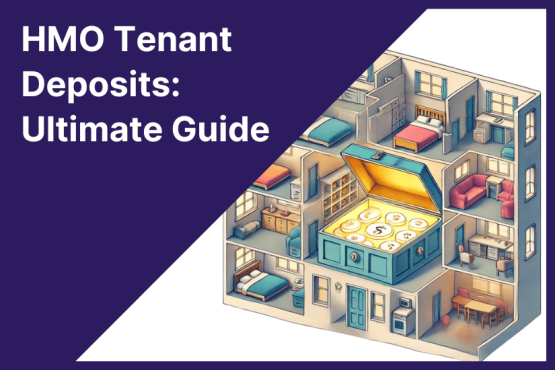In this article, we’ll break down everything HMO landlords need to know about tenancy deposits—from legal requirements to best practices—so you can stay compliant and protect your property interests.
Introduction to HMOs
In the UK, HMOs are subject to specific laws and guidelines to ensure the safety and well-being of tenants. One of the primary requirements is obtaining an HMO licence from the local council. This licence ensures that the property meets the necessary standards for multiple occupation, including adequate kitchen and bathroom facilities, fire safety measures, and proper maintenance.
HMO landlords must also comply with regulations related to deposit protection and tenancy agreements. Deposits must be protected in a government-approved deposit protection scheme, and clear, written tenancy agreements should be provided to each tenant. By adhering to these regulations, landlords can protect their property interests and maintain a positive relationship with their tenants.
What Is a Tenancy Deposit?
A tenancy deposit is a sum of money paid by a tenant at the beginning of an assured shorthold tenancy to cover potential damages, unpaid rent, or breach of contract. For most Assured Shorthold Tenancies (ASTs), this is typically capped at five weeks’ rent if the annual rent is less than £50,000 (or six weeks if above).
It’s important to distinguish between a tenancy deposit, which must be protected by law, and a holding deposit, which is a smaller amount used to reserve a property before the tenancy agreement is signed. Once a holding deposit is converted into a full deposit upon tenancy start, it must be properly registered in an authorised protection scheme.
Legal Requirements for HMO Deposits
Under the Housing Act 2004, landlords are legally required to protect any deposit taken for an AST in one of the UK’s three government-approved tenancy deposit schemes. This must be done within 30 calendar days of receiving the deposit.
Each local authority is responsible for enforcing HMO regulations and issuing licenses, with specific application processes and fees that vary by region.
In addition to registering the deposit, landlords must also provide the tenant with Prescribed Information, which includes:
The name and contact details of the deposit scheme
The address of the property
The amount of the deposit
How the deposit is protected
How to apply for the return of the deposit
What to do in the event of a dispute
Failing to protect a deposit or issue the prescribed information within the 30-day window can invalidate any Section 21 eviction notice, and expose the landlord to financial penalties of 1 to 3 times the deposit amount, even after the tenancy ends.
Failure to comply with these legal requirements can result in tenants taking legal action against the landlord, potentially leading to court proceedings and significant financial penalties.
HMO Licences and Regulations
HMO licences are mandatory for properties housing five or more tenants who are not part of the same household. These licences are typically issued by the local council and are valid for a specific period, usually five years. To obtain an HMO licence, landlords must meet several criteria designed to ensure the property is safe and suitable for multiple occupants.
For a large HMO, landlords face unique challenges and requirements, including maintaining higher safety standards and ensuring the property is well-managed to cater to multiple tenants. The landlord’s track record in managing such properties is often scrutinized to ensure compliance with regulations.
Key requirements include providing adequate kitchen and bathroom facilities to accommodate all tenants, ensuring the property meets HMO standards, and implementing essential safety measures such as fire alarms and emergency exits. Additionally, landlords must register with the local council and provide their contact details to facilitate communication and compliance checks.
Meeting these criteria not only helps in obtaining the HMO licence but also ensures the property is safe and comfortable for tenants, thereby reducing the risk of legal issues and enhancing the property’s value.
Approved Deposit Protection Schemes
There are three government-approved tenancy deposit schemes in England and Wales:
Deposit Protection Service (DPS)
MyDeposits
Tenancy Deposit Scheme (TDS)
Lenders often require proof that deposits are protected under an approved scheme as part of the mortgage application process for HMO properties.
Each scheme offers two types of protection:
Custodial schemes: The scheme holds the deposit for free and returns it at the end of the tenancy.
Insurance-based schemes: The landlord keeps the deposit but pays a fee or premium to insure it against non-compliance.
For HMO landlords managing multiple tenants, custodial schemes are often preferred for simplicity, especially when dealing with staggered tenancy start and end dates. However, some landlords choose insurance schemes to retain more control over the funds.
Joint vs Individual Tenancies in HMOs
Deposit handling depends heavily on how the HMO is let.
HMOs typically involve tenants from different households, each with their own tenancy agreement and deposit.
In a joint tenancy, all tenants are listed on a single agreement, and a single deposit is taken. The tenants share equal responsibility for the condition of the property and rent payments. If one tenant causes damage or leaves early, the whole group may be liable.
For example, in a joint tenancy, if one tenant fails to pay their share of the rent, the other tenants must cover the shortfall to avoid breaching the agreement.
In contrast, individual tenancies (common in HMOs) involve separate agreements and separate deposits for each tenant. Each deposit must be registered individually, and each tenant must receive their own prescribed information and protection certificate.
This setup offers more flexibility and clearer responsibilities, but requires the landlord to stay organised and maintain accurate records for each tenancy.
Returning the Deposit
At the end of the tenancy, the landlord must assess whether the tenant is entitled to a full deposit refund. Ensuring the deposit paid by the tenant is returned promptly and fairly is crucial to maintaining a positive landlord-tenant relationship. The deposit can only be withheld (partially or fully) for legitimate reasons, such as:
Unpaid rent
Damage beyond fair wear and tear
Removal of abandoned belongings
Breach of tenancy terms (e.g., unapproved alterations)
Landlords should conduct a detailed check-out inspection, ideally with a comparison to the check-in inventory, supported by dated photographs. If any deductions are proposed, they should be clearly itemised and shared with the tenant.
If there’s a dispute, all three protection schemes offer free Alternative Dispute Resolution (ADR) services. This avoids the need for court proceedings and provides a fair judgment based on submitted evidence.
Deposits must be returned (or a dispute raised) within 10 days of agreement, or the scheme’s formal process must be initiated.
What Happens If You Don’t Comply?
Non-compliance with deposit protection legislation can be costly. If a landlord fails to protect a deposit or provide the required documentation, tenants can:
Claim 1–3 times the deposit amount as compensation
Prevent the landlord from serving a valid Section 21 notice
Apply to the county court for enforcement, even after moving out
Tenants can also take legal action to claim compensation if their deposit is not protected or if the required documentation is not provided.
These penalties apply regardless of whether the tenancy was otherwise well-managed. In HMOs, where multiple deposits may be held simultaneously, the risk multiplies. A single mistake repeated across tenancies could result in thousands of pounds in fines.
Government Support
The UK government offers various schemes and incentives to support HMO landlords and tenants. For instance, the Help to Buy scheme can assist first-time buyers with deposit payments, making it easier to invest in HMO properties. This scheme can be particularly beneficial for new landlords looking to enter the HMO market.
Additionally, the government’s deposit protection scheme ensures that tenants’ deposits are safeguarded and can be returned at the end of the tenancy, fostering trust and transparency between landlords and tenants. HMO landlords can also benefit from the Rent a Room scheme, which allows them to earn tax-free income from renting out a room in their property, providing a cost-effective way to maximize rental income.
Furthermore, the government provides extensive guidance and resources for HMO landlords on various topics, including tenancy agreements, rental payments, and safety measures. By leveraging these government schemes and resources, HMO landlords can enhance their property management practices and ensure compliance with legal requirements.
By integrating these new sections, the article now provides a comprehensive overview of HMO deposits, licences, regulations, and government support, offering valuable insights for both new and experienced HMO landlords.
Best Practices for HMO Landlords
Managing deposits in HMOs can be streamlined with a few core practices:
Always issue written tenancy agreements with clear clauses on deposits and deductions
Conduct thorough check-in and check-out inventories, ideally signed by both parties
Register deposits within 30 days without fail, and send the prescribed information promptly
Keep communication open with tenants regarding any proposed deductions
Document all charges with receipts and photographic evidence
As an HMO landlord, it is crucial to adhere to responsibilities and best practices to ensure tenant safety and satisfaction, while also complying with legal requirements.
If managing multiple tenancies becomes unmanageable, consider outsourcing to a reputable letting agent or using property management software to automate reminders and document storage.
FAQs
Do I need to protect deposits for lodgers or licensees?
No. Deposit protection rules only apply to Assured Shorthold Tenancies, not to lodgers or non-AST agreements.
Can I charge more than five weeks’ rent as a deposit?
Not unless the annual rent exceeds £50,000. Above that, you may charge up to six weeks’ rent. Otherwise, you risk breaching the Tenant Fees Act 2019.
What if a tenant moves rooms within the HMO?
If a new tenancy agreement is created, the deposit should be returned and re-taken under the new terms. If not, update the agreement in writing and confirm continued protection under the same scheme.
Conclusion
Getting deposit protection right is non-negotiable for HMO landlords. Beyond the legal requirements, it’s also a matter of trust and professionalism. Tenants are more likely to respect the property and meet their obligations when they know their deposit is handled fairly.
Ensuring the deposit paid by tenants is protected and managed correctly is essential for compliance and building trust with tenants. This is particularly important for rental property owners who must adhere to specific HMO mortgage criteria.
By understanding your obligations, choosing the right scheme, and keeping good records, you can avoid costly disputes and protect both your income and your reputation.
For more guidance, visit the official government tenancy deposit page or speak to your deposit protection scheme directly.


